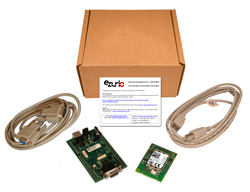We recommend using de-ionized water. Additionally, we recommend avoiding any sonic vibration, heat, and pressure washing as well as any other soaps/chemicals.
BTM461

Enhanced Bluetooth 2.1+EDR module
Specifications
Documentation
Browse Certifications, Documentation and Product Briefs in our Support & Documentation Center.
Distributors
Sorry, no inventory of this part found at this time. Please contact us to purchase.
Who is responsible for providing the Bluetooth QDID for a host system?
The responsibility for providing the QDID for a host system is with the provider of the stack that is used on that system. If for instance the host system uses a module that requires the Bluetooth stack to run on that system (e.g. Lairds Sterling-LWB in a Linux platform) the QDID must be provided by the stack vendor who's stack is running on that Linux platform. Challenges might occur when an open-source, community based stack is used. If a module with integrated stack us used (e.g. Lairds BL652) the QDID is provided by the module vendor.
What criteria should be confirmed when soldering Bluetooth modules?
The factors to confirm when checking the soldering job on Bluetooth modules are solder stencil aperture size, solder stencil thickness, solder ball size, solder type, and the MSL guidelines. If the parts have been left out for too long then the modules should be baked to remove any moisture prior to soldering. If there are any failures, we highly recommend providing an x-ray of the module.
Does Ezurio provide 3D files for modules?
Ezurio provides 3D files (STEP) files for most but not all of it's modules. Based on the nature of the information in the files, in most cases Laird requires a login to access these files as well as layout files and software/firmware downloads. As such, for most modules, the 3D files are found under the Software Downloads tab of the product page. The page offers a credentials request link for customers who need credentials. In most cases, the credentials are provided via return email within about 10 minutes. Please contact support if you have any additional questions or have any issues accessing our downloads.
Do we recommend conformal coating your modules?
We highly do not recommend conformal coating the radio module. If you plan on encapsulating the radio module in a potting compound or conformal coating, you must assure that the compound in liquid or solid form does not enter under the shield where there are sensitive RF components. Some of the capacitive and inductance values are as low (pF and nH) and could be sensitive to contacting materials such as potting compounds. There are potting compounds and conformal coatings which have very good dielectric constants and are suitable for 2.4 GHz potting applications, however, when you apply any of these, they were not accounted for in the circuit design and might reduce performance of the device (or all together cause it not to function). You should run tests on their particular potting compound and evaluate radio's performance and range. Also, it's worth mentioning that applying any compound, conformal coating or potting directly to the module WILL void the warranty. If your application requires 100% sealing of the radio module, there is a way to do this very successfully without impacting the module performance. Simply place the module on your PCB. Place a plastic cover over the module (like a hat), make the cover large enough to cover the whole module. Apply glue around the bottom perimeter of the cover where it sits on the PCB. This allows the module to function in free air-space while there is a complete seal around it. This information is only for reference and we recommend you should conduct your own testing with your prototype of your end application to find the best suitable fit for your design.
How many reflows do you recommend for your modules?
We only recommend reflowing our modules once as it can damage the module and void the warranty.
Are Ezurio's BT/ BLE Modules "Intrinsically Safe"?
Yes it is possible that Laird's BLE modules could be utilized in a end device that is certified as"Intrinsically Safe". We do not currently have any end customers doing this with all of Laird's BT/BLE modules, some of our BT/BLE modules have been successfully certified by our customers. As a valuable point of information, Intrinsically Safe certifications are detailed and extensive, requiring NDA restricted information on our modules which we can support based on the commercial opportunity. The detailed analysis and testing of the end production solution is the responsibility of the end customer working with their certified test house.
What are the available CAD file formats?
Ezurio provides layout files PADS and PADS ASCII formats. The ASCII files will import to Altium (and Protel varients) as well as Cadence (Orcad and Allegro) CAD packages. As far as we know, there is no way to import to Eagle CAD. Please be sure to use the .asc file for PCB and the .txt file for the schematic when importing to Altium. Ezurio uses ORCAD for schematics (Gerbers).
What's the recommended process to clean modules?
The recommended cleanser is "hydrocarbon cleaning oil", which can be used to clean the RF shield and PCB. We do not recommend the use of alcohol as it doesn't work as well and could leave residue on the boards.
